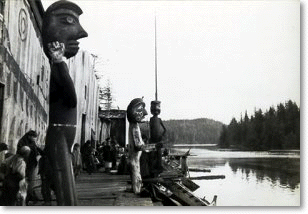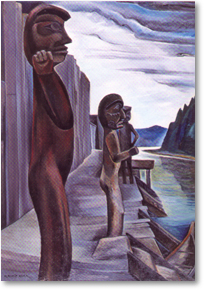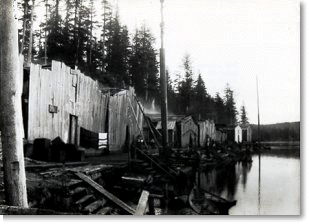Ba'a's
 "Blunden harbour, Q.C. Sd. After Edward Raynor Blunden, R.N., master's assistant, H.M. surveying vessel Hecate, 1861."
"Blunden harbour, Q.C. Sd. After Edward Raynor Blunden, R.N., master's assistant, H.M. surveying vessel Hecate, 1861."
Walbran 1909:56
"This enlargement from a 4 x 5 negative was loaned to Miss Emily Carr about 1930 by W.A. Newcombe. Miss Carr painted 'Blunden Harbour' [in] the National Gallery, Ottawa from it--never having had an opportunity of visiting this village personally. (signed) W.A. Newcombe"
Audio-Visual Collections, Anthropology Section, RBCM

"About the year 1894, the head chief and a party were hunting at Paás (Blunden Harbour), when his son fell ill, and, about to die, begged them: 'Do not bury me at Téquhsta, for there they eat the dead. Bury me here.' So they placed his body on a small island, and the chief told the people that he would remain there until he died. But rather than give up their chiefs, the people left Téquhsta and went to Paás, where they have since maintained their winter residence."
Curtis 1915:307
"This place: Ba'as (Blunden Harbour) the people moved here when W. Siwid (Willie Seaweed, born ca. 1873, Chief Hilamas of the Naxwakdakw, renowned artists and carver) was very small. His grandfather, a hunter, had camped here previously. One day, grandfather saw a bakwas (wild-man of the woods) sunning on the beach. Called wife, son. Son looked, saw (the bakwas), got sick and died. Buried here so grandfather stayed and [his tribe] came and lived here."
Chief Willie Seaweed. Wilson Duff, personal communication, Blunden Harbour 1955.

"Now I'll tell the history of my house, beginning, with the first chief of my numaym (lineage), Walas, who had for their chief my ancestor, who came from the first Tlakwagila.
"Helestes went spouting around our world, and he went into Blunden Harbour; and he went ashore from his travelling-canoe, Killer-Whale-Mask; and he liked the place because it had a good sandy beach."
Boas 1921:885
On to Xwatis
See more paintings of Ba'a's
See more photographs of Ba'a's
|

